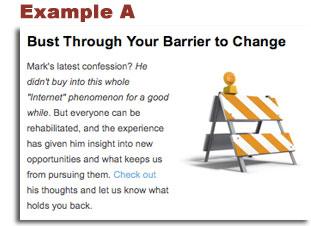Email Best Practices Aren't Always Best
Suscribers to our awe-inspiring, world-renowned email newsletter may have noticed that I've been making some changes lately. Indeed, I've been tinkering with and testing this tool since assuming control and production, though I'd venture to say most of the changes have been subtle. The most-recent alteration, however, was somewhat significant.
For the most part, our newsletter has featured the best practice of teasing individual blog posts. It makes sense, on the surface; hook 'em with a quick header, a witty sentence or two describing the post, and link to your blog. Example A, on the right, followed that model. Please note AMac's excellent choice of art.
Our reinvigorated emphasis on publishing, however, has given me more material from more authors, and I wanted to see if I could successfully showcase their words while maintaining or increasing click rates on our newsletters. The best way to accomplish this, I figured, was to use the post's given headline and copy along with a byline listing the author.
Example B, also on the right, shows the result. This turned March's newsletter into a bit of a "Try-before-you-buy" kind of tool, as I was able to fit in at least two paragraphs on each post. I feel this brought a level of personalization that our newsletter has lacked. Additionally, it was a relatively significant time-saver for me, as I was spared from having to write all-new headers and teasers for each post.
On the other hand, there are some drawbacks to this approach. For one, it puts me (and our readers) at the mercy of our blog; I believe our posts are always informative and useful, but different authors means different writing styles, ledes, headlines, and more. Not all posts will work with this format. Moreover, space considerations may keep us from highlighting as many posts as we wish.
Early test results confirm: change is good
My time considerations aside, what matters is how our readers respond to any format change; so far, I'm pleased with the numbers. First off, I should note that I tested the two formats on a subset of our subscriber base using the handy A/B testing tool provided by CampaignMonitor, our email campaign service of choice. That allowed me to test our traditional format against the new one, and the latter got more link clicks. Check one for change.
Almost two weeks from the campaign send, the aggregate numbers also looked promising. Historically, our click rates have varied between 15-45 percent, and it's been challenging to identify causal relationships. Still, the last few months have been in the low 20s, so seeing the new format push that number to almost 30% was pleasing. Certainly, click rates aren't our only goal—not even a big one, necessarily—but they are a part of multivariate and multilevel testing.
The end game, as Mark has said, is about gaining insight. And we're willing to go against best practices if it means providing our customers greater value while increasing our conversion rate. But it's not all about us, and it's not just about writing more/less or changing a teaser format. Check back shortly, as we'll cover some other email best practices that may not be best for you.
MONTHLY MARKETING INSIGHTS.
Get thought-provoking and actionable insights to improve how your firm makes a connection with your customers.





LEAVE A COMMENT